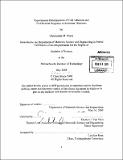| dc.contributor.advisor | Krystyn J. Van Vliet. | en_US |
| dc.contributor.author | Bruce, Christopher M | en_US |
| dc.contributor.other | Massachusetts Institute of Technology. Dept. of Materials Science and Engineering. | en_US |
| dc.date.accessioned | 2010-09-01T13:35:44Z | |
| dc.date.available | 2010-09-01T13:35:44Z | |
| dc.date.copyright | 2008 | en_US |
| dc.date.issued | 2008 | en_US |
| dc.identifier.uri | http://hdl.handle.net/1721.1/57970 | |
| dc.description | Thesis (S.B.)--Massachusetts Institute of Technology, Dept. of Materials Science and Engineering, 2008. | en_US |
| dc.description | Cataloged from PDF version of thesis. | en_US |
| dc.description | Includes bibliographical references (p. 27-28). | en_US |
| dc.description.abstract | Controlling cell behavior has been a primary goal for scientists, and physical interactions, specifically cell-surface interactions, have the potential to be a robust system for cell control. Much research has been conducted on the effect of substrata stiffness on cell behavior, but there has been no systematic study of the effect of varying substrata thickness, and its correlation to a substratum's effective stiffness that a cell feels. Furthermore, there have been differing views on what the critical thickness of a substrate is, above which there will be no difference in cell behavior. An experimental study was carried out to determine the effects of substratum thickness on the behavior of cells adhering to polyacrylamide thin film gels functionalized with gelatin. Relatively compliant thin film gels, with an elastic modulus E ~ 5 kPa, were varied in thickness on stiff glass supports from ~75 nm to 60 microns. 3T3 fibroblast cells were seeded onto the gels to observe differences in behavior. Observed cell behaviors were the projected area of the cells on the surface due to adhesive spreading and the rate of reduction of Alamar Blue dye, which correlates to the proliferation, or growth rate, of the cells. It was found that the cell area had a fairly welldefined power-law dependence on substrate thickness, while the gel thickness did not have a detectable effect on the rate of proliferation of the cells. Additionally, a theoretical model for thin film deflection was fit to the cell area data, and it described the areathickness relationship well. | en_US |
| dc.description.abstract | (cont.) By using the theoretical model, a critical thickness of 2.3 tm was identified over which average cell area would not change significantly. This critical thickness was found to be on the order of the reported length scale of focal adhesions in the cells, not the lateral dimensions of the cell. These results are useful in establishing a practical lower limit of'film thickness for normal cell behavior. Additionally, this relationship could be exploited as a way to control stem cell differentiation, cell size, cell motility, cell ligand density, and other cell behaviors. | en_US |
| dc.description.statementofresponsibility | by Christopher M. Bruce. | en_US |
| dc.format.extent | 28 p. | en_US |
| dc.language.iso | eng | en_US |
| dc.publisher | Massachusetts Institute of Technology | en_US |
| dc.rights | M.I.T. theses are protected by
copyright. They may be viewed from this source for any purpose, but
reproduction or distribution in any format is prohibited without written
permission. See provided URL for inquiries about permission. | en_US |
| dc.rights.uri | http://dspace.mit.edu/handle/1721.1/7582 | en_US |
| dc.subject | Materials Science and Engineering. | en_US |
| dc.title | Experimental determination of cell adhesion and proliferation response to substrata thickness | en_US |
| dc.type | Thesis | en_US |
| dc.description.degree | S.B. | en_US |
| dc.contributor.department | Massachusetts Institute of Technology. Department of Materials Science and Engineering | |
| dc.identifier.oclc | 618653413 | en_US |
